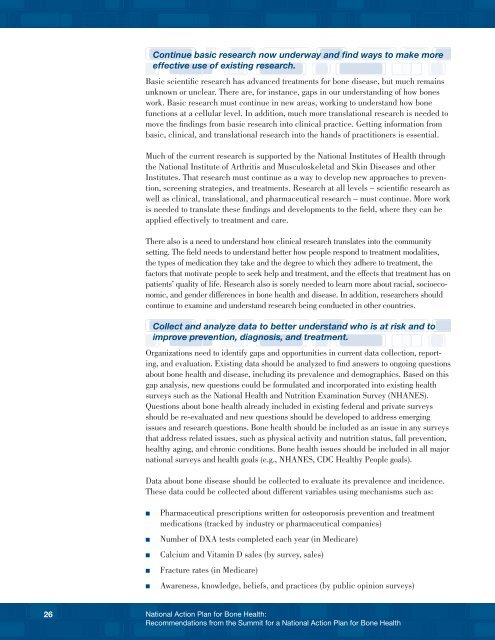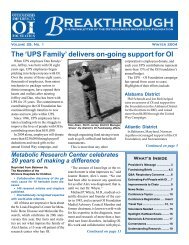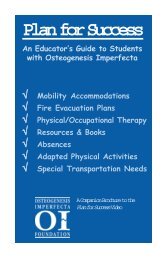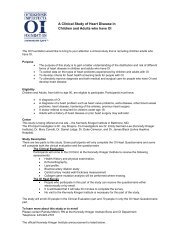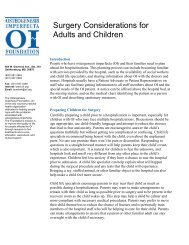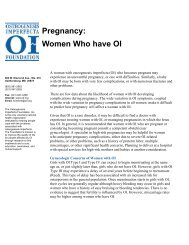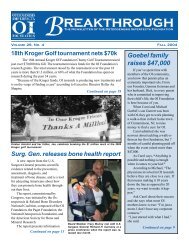National Action Plan for Bone Health - Osteogenesis Imperfecta ...
National Action Plan for Bone Health - Osteogenesis Imperfecta ...
National Action Plan for Bone Health - Osteogenesis Imperfecta ...
You also want an ePaper? Increase the reach of your titles
YUMPU automatically turns print PDFs into web optimized ePapers that Google loves.
Continue basic research now underway and find ways to make more<br />
effective use of existing research.<br />
Basic scientific research has advanced treatments <strong>for</strong> bone disease, but much remains<br />
unknown or unclear. There are, <strong>for</strong> instance, gaps in our understanding of how bones<br />
work. Basic research must continue in new areas, working to understand how bone<br />
functions at a cellular level. In addition, much more translational research is needed to<br />
move the findings from basic research into clinical practice. Getting in<strong>for</strong>mation from<br />
basic, clinical, and translational research into the hands of practitioners is essential.<br />
Much of the current research is supported by the <strong>National</strong> Institutes of <strong>Health</strong> through<br />
the <strong>National</strong> Institute of Arthritis and Musculoskeletal and Skin Diseases and other<br />
Institutes. That research must continue as a way to develop new approaches to prevention,<br />
screening strategies, and treatments. Research at all levels – scientific research as<br />
well as clinical, translational, and pharmaceutical research – must continue. More work<br />
is needed to translate these findings and developments to the field, where they can be<br />
applied effectively to treatment and care.<br />
There also is a need to understand how clinical research translates into the community<br />
setting. The field needs to understand better how people respond to treatment modalities,<br />
the types of medication they take and the degree to which they adhere to treatment, the<br />
factors that motivate people to seek help and treatment, and the effects that treatment has on<br />
patients’ quality of life. Research also is sorely needed to learn more about racial, socioeconomic,<br />
and gender differences in bone health and disease. In addition, researchers should<br />
continue to examine and understand research being conducted in other countries.<br />
Collect and analyze data to better understand who is at risk and to<br />
improve prevention, diagnosis, and treatment.<br />
Organizations need to identify gaps and opportunities in current data collection, reporting,<br />
and evaluation. Existing data should be analyzed to find answers to ongoing questions<br />
about bone health and disease, including its prevalence and demographics. Based on this<br />
gap analysis, new questions could be <strong>for</strong>mulated and incorporated into existing health<br />
surveys such as the <strong>National</strong> <strong>Health</strong> and Nutrition Examination Survey (NHANES).<br />
Questions about bone health already included in existing federal and private surveys<br />
should be re-evaluated and new questions should be developed to address emerging<br />
issues and research questions. <strong>Bone</strong> health should be included as an issue in any surveys<br />
that address related issues, such as physical activity and nutrition status, fall prevention,<br />
healthy aging, and chronic conditions. <strong>Bone</strong> health issues should be included in all major<br />
national surveys and health goals (e.g., NHANES, CDC <strong>Health</strong>y People goals).<br />
Data about bone disease should be collected to evaluate its prevalence and incidence.<br />
These data could be collected about different variables using mechanisms such as:<br />
n<br />
n<br />
n<br />
n<br />
n<br />
Pharmaceutical prescriptions written <strong>for</strong> osteoporosis prevention and treatment<br />
medications (tracked by industry or pharmaceutical companies)<br />
Number of DXA tests completed each year (in Medicare)<br />
Calcium and Vitamin D sales (by survey, sales)<br />
Fracture rates (in Medicare)<br />
Awareness, knowledge, beliefs, and practices (by public opinion surveys)<br />
26 <strong>National</strong> <strong>Action</strong> <strong>Plan</strong> <strong>for</strong> <strong>Bone</strong> <strong>Health</strong>:<br />
Recommendations from the Summit <strong>for</strong> a <strong>National</strong> <strong>Action</strong> <strong>Plan</strong> <strong>for</strong> <strong>Bone</strong> <strong>Health</strong>


